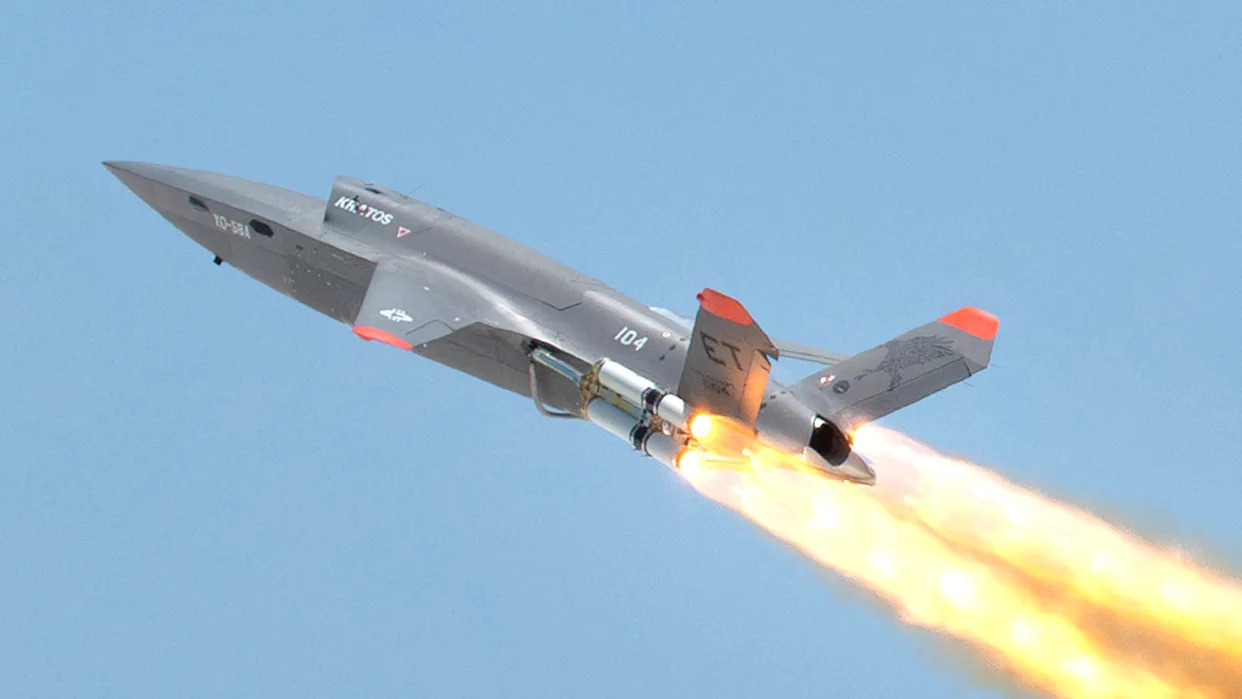
Additional versions of the stealthy XQ-58A Valkyrie drone could be on the horizon for two potential new customers, manufacturer Kratos says. This follows announcements that the U.S. Marine Corps is moving to transition its experimental work with the XQ-58 into a full program of record and about a partnership with Airbus to craft a version of the Valkyrie for the German Luftwaffe.
Kratos’ CEO Eric DeMarco talked extensively about new developments regarding the XQ-58 during a quarterly earnings call last week. The Valkyrie, the baseline version that first flew in 2019, has already expanded into a broad family with several known variants and derivatives. This includes a Conventional Takeoff and Landing (CTOL) type with built-in tri-cycle landing gear that was first announced last year. The uncrewed aircraft was originally designed to get airborne via ground-based launchers with the help of expendable rocket boosters and land via a parachute recovery system. Kratos has also developed a special launch trolley to allow types without landing gear to take off from traditional runways and has shown a concept for a containerized launch system in the past. The Air Force and Marine Corps are the only known operators of XQ-58s now, and they have been using them for test and evaluation purposes.
“In Kratos’ tactical drone business, it was recently reported that both the U.S. Marine Corps and the Office of the Secretary of Defense stated that the Valkyrie is becoming a program of record and will be the first CCA [Collaborative Combat Aircraft] in production and fielded for the Marines,” DeMarco said, according to a transcript of the call published on Investing.com. “Additionally, Airbus recently announced that they have partnered with Kratos for a European mission-focused Valkyrie and initially specifically targeting the German Luftwaffe with the current expectation for fielding no later than 2029.”
“In addition to the US Marine Corps and Airbus, Valkyrie-related opportunities that have been reported, we have two new additional Valkyrie opportunities with two different customers, both of which I believe Kratos is currently in a sole-source position,” he continued. “As a result of recent Valkyrie related progress, we have now begun the process of pricing out with our already in place and performing qualified suppliers, the long lead purchasing and the program planning for an expanded production run of at least 24 additional Valkyries, which would sustain and build on the current learning curve from the initial 24 and would bring the total Valkyrie serial production run to 48 aircraft. Across the potential increased Valkyrie production run, we would be producing several variants, including runway-independent, combined runway-independent/runway-capable, CTOL, a European-focused variant, and potentially two additional variants, all of which are specifically potential customer-focused.”

DeMarco did not provide any further details about the XQ-58 variants the company is developing for the Marines or in partnership with Airbus, or ones that it could start work on if it secures the contracts with the other two potential customers.
In May, Steve Fendley, president of Kratos’ Unmanned Systems Division, told TWZ that multiple configurations were being finalized for the Marines. Electronic warfare has been a centerpiece of the Marine Corps’ testing of the XQ-58 to date, and is expected to be a key focus area for any operationalized version of the drone for that service, which has been referred to as the MQ-58B in the past. The ability to conduct kinetic strikes also seems likely to be on the list of desired capabilities. The Valkyrie has a demonstrated ability to release payloads from an internal bay. Kratos has shown renderings of versions capable of carrying munitions and other stores under their wings.


The Marine Corps has also reportedly expressed interest in the landing gear-equipped versions of the Valkyrie. In the past, TWZ has highlighted how runway-independent variants would align well with the service’s new expeditionary and distributed concepts of operations that center heavily on the ability to deploy and redeploy forces to far-flung operating locations, including ones with limited infrastructure.

When it comes to the European-focused version that Kratos is now developing with Airbus, details are also limited beyond a statement that it will feature what is described as a “platform-agnostic system architecture.”
“They want, for their specific mission application, their mission system or NATO’s mission system, if you will, or a certain customer we’re working with in the Pacific, their mission system they want that on it, it’ll be integrated and delivered that way,” DeMarco did say later on in last week’s call. He was responding to a question about the XQ-58, but whether or not he was speaking specifically here about Valkyrie, including alluding to a potential sale to a Pacific customer, is unclear. The Kratos CEO also mentioned “Airwolf and another one that I’m not talking about” in his response.
Airwolf is a smaller tactical uncrewed aircraft derived from the MQM-178 Firejet target drone, which you can read more about here. In the earnings call, DeMarco separately mentioned that Kratos expects to receive a sole-source contract for Airwolf drones before the end of the year.

Kratos’ drone portfolio contains a number of other known designs, as well as classified projects. This includes the as-yet-unseen Apollo and Athena, which are unrelated to the XQ-58, and are being developed with a particular eye toward the European market, as you can read more about here. Athena, at least, is now in flight testing.
“Valkyrie has flown from multiple U.S. sites in multiple scenarios. Valkyrie, identified by the Office of the Secretary of Defense and the Marines as a CCA, has collaboratively operated with multiple manned military aircraft and has collaboratively cooperated [with] multiple Valkyries, not surrogates, not computer models, not pretty pictures, actual Valkyrie systems,” DeMarco also said about the XQ-58 during last week’s call. “All of these flights and events have occurred in coordination and cooperation with our military customers. Valkyrie exists, is flying and has been flying since 2019. The Valkyrie is real.”

“This is why Airbus partnered with Kratos. Airbus wants to work with the company that has real flying products and aircraft that have flown with the F-35, for example, and flown with the … F-22. Not just promises. I find it interesting that other companies are routinely making claims of what their systems will be and capabilities it will have. I consistently tell you on these calls what we have done, what we’re going to do, we do it, what our systems are, our actual successful missions, and our specific customers.”

DeMarco’s comments were clearly aimed at the U.S. Air Force’s very high-profile Collaborative Combat Aircraft (CCA) program. Kratos was prominently absent from the competition to build the first tranche of CCA drones for the Air Force, with General Atomics and Anduril being selected to develop what are now designated the YFQ-42A and the YFQ-44A, respectively. Both of those designs are expected to fly for the first time this year. General Atomics has been directly leveraging work done already on the experimental XQ-67A, which flew for the first time last year.

Kratos has expressed interest in the past in joining the competition for a second tranche of CCAs for the Air Force, the requirements for which were said to have been in the process of being finalized earlier this year. Air Force officials have said they could be looking for designs that are cheaper and less exquisite this time around.
“I have to be very, very careful. I’ll never speak for the customer,” DeMarco said last week when asked about this. “I will say that recently representatives of the Air Force have been saying publicly that maybe less than exquisite, more affordable, and in higher quantities is a better way to go than exquisites that haven’t even flown yet.”
Whatever the future may hold for the XQ-58 when it comes to the Air Force or other potential customers, Kratos is continuing to invest heavily in the still-growing Valkyrie family, and with an eye toward new markets, including ones outside of the United States.
Contact the author: [email protected]








Comments